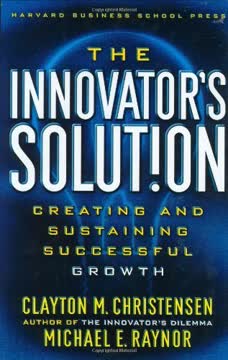重点摘要
1. 颠覆性技术通常从小型、被忽视的市场开始
颠覆性技术通常能够催生新市场的出现。
小起点,大影响。 颠覆性技术往往出现在小型、低端市场,这些市场通常被现有企业忽视或认为无利可图。这些技术在主流市场初期表现不佳,但在新应用中表现出色。例子包括:
- 个人电脑:最初被视为玩具,但颠覆了小型计算机和大型主机
- 液压挖掘机:从小型建筑项目开始,最终取代了电缆驱动的机器
- 磁盘驱动器:较小的驱动器最初在新兴市场(如便携设备)中出现,随后进入了成熟市场
随着这些技术的改进,它们最终满足了主流市场的需求,通常以更低的成本或更高的便利性,导致行业的剧变。
2. 现有企业因资源分配而难以应对颠覆性创新
管理者按照既定的规则进行决策和资源分配,这些过程是现有公司成功的关键,但也正是这些过程拒绝了颠覆性技术。
资源分配决定创新。 现有公司难以应对颠覆性技术并非因为技术能力不足,而是因为它们的资源分配过程。这些过程旨在支持:
- 高利润产品
- 大型市场
- 现有客户的需求
颠覆性创新通常:
- 提供较低的利润率
- 针对较小、未定义的市场
- 不满足当前客户的需求
因此,颠覆性项目在现有公司内部的资源竞争中一再失败,即使高层管理支持它们。
3. 创新者的两难:良好的管理可能导致失败
良好的执行、快速上市、全面质量管理和流程再造同样无效。
成功孕育失败。 创新者的两难在于,导致现有市场成功的管理实践在面对颠覆性技术时可能导致失败。这些实践包括:
- 密切倾听客户
- 投资于高性能、高利润产品
- 专注于大型、增长中的市场
虽然这些方法对维持性创新有效,但它们系统性地导致公司错过颠覆性机会。管理者面临两难:确保当前成功的做法可能为未来的失败埋下种子。
4. 市场需求与技术改进轨迹预测颠覆
这意味着,成功公司中最优秀的高管在管理创新方面学到的许多东西对颠覆性技术并不适用。
轨迹揭示机会。 理解市场需求和技术改进的轨迹对于预测颠覆潜力至关重要。关键概念:
- 性能过剩:当技术改进超过市场需求
- 轨迹交叉点:颠覆性技术满足主流需求的点
分析这些轨迹有助于管理者:
- 识别潜在的颠覆性威胁
- 发现创新机会
- 把握新技术进入市场的时机
那些将战略与这些轨迹对齐的公司更有可能防御或利用颠覆性创新。
5. 为颠覆性创新创建独立组织至关重要
只有CEO才能确保新组织获得所需资源,并能够自由创建适应新挑战的流程和价值观。
自主性促进颠覆。 为了成功追求颠覆性创新,现有公司应创建独立的组织。这种方法:
- 允许不同的成本结构和利润预期
- 专注于小型、新兴市场
- 允许开发新的流程和价值观
关键考虑因素:
- 独立组织应足够小,以便对小胜利感到兴奋
- 需要在资源分配上有独立性
- 需要CEO级别的支持和关注
成功的分拆例子包括IBM的PC部门和强生公司在医疗设备方面的做法。
6. 发现新市场需要实验而非市场研究
在颠覆性技术的不确定性中,管理者可以始终依赖一个锚点:专家的预测总是错误的。
行动胜于分析。 传统的市场研究对颠覆性技术无效,因为这些市场尚不存在。相反,公司应:
- 采用发现驱动的规划方法
- 计划出错并快速学习
- 使用低成本的探测和实验来测试市场
成功策略:
- 观察客户的行为,而不仅仅是他们的言辞
- 创建产品并观察客户如何使用
- 准备根据市场反馈进行迭代和调整
本田在美国摩托车市场的成功和英特尔进入微处理器的历程就是这种实验性市场发现方法的例子。
7. 性能过剩引发竞争基础的转变
一旦对容量的需求得到满足,其他尚未满足市场需求的属性变得更有价值,并成为驱动制造商寻求产品差异化的维度。
过剩重塑市场。 当产品性能超过市场需求时,竞争基础发生转变。这个过程通常遵循一个模式:
- 功能性
- 可靠性
- 便利性
- 价格
当一个属性变得“足够好”时,客户开始重视其他特性。这种转变为颠覆性技术创造了机会,这些技术在传统指标上可能较差,但在新兴指标上更优。
例子:
- 磁盘驱动器:从容量转向尺寸和功耗
- 会计软件:从功能性转向易用性(如Intuit的成功)
- 胰岛素:从纯度转向便利性
8. 组织能力存在于流程和价值观中,而不仅仅是资源
组织的能力独立于其员工的能力而存在。组织的能力存在于其流程和价值观中。
流程和价值观定义能力。 一家公司的创新能力不仅取决于其资源(人员、技术、资本),还取决于其:
流程:
- 工作如何完成
- 沟通模式
- 决策程序
价值观:
- 设定优先级的标准
- 什么定义了“好”项目
这些元素往往变得根深蒂固,以至于它们定义了一个组织能做什么和不能做什么,无论涉及到的个人是谁。这解释了为什么:
- 现有公司在维持性创新方面表现出色
- 它们在应对不符合现有流程和价值观的颠覆性技术时表现不佳
9. 管理创新需要将挑战与组织能力匹配
在我们这个应对加速变化能力变得如此关键的时代,确保有能力的人在有能力的组织中是管理的主要责任。
匹配挑战与组织。 成功的创新管理需要将创新类型与合适的组织结构对齐。关键考虑因素:
- 评估现有流程是否适合创新挑战
- 确定当前价值观是否支持该计划
- 选择合适的组织结构:
- 功能团队以利用现有能力
- 重量级团队以创建新流程
- 自主组织以发展新价值观
通过将创新挑战与合适的组织能力匹配,管理者可以增加维持性和颠覆性创新成功的机会。
最后更新日期:
FAQ
What's The Innovator's Dilemma about?
- Focus on Company Failures: The book examines why successful companies often fail when faced with disruptive technologies, despite having strong management practices.
- Disruptive vs. Sustaining Technologies: It differentiates between sustaining technologies that enhance existing products and disruptive technologies that initially underperform but eventually dominate the market.
- Case Studies: Christensen uses examples from industries like disk drives and excavators to show how established firms often miss disruptive innovations.
Why should I read The Innovator's Dilemma?
- Understanding Innovation Dynamics: The book offers insights into how companies can navigate technological changes effectively.
- Practical Framework: It provides a framework for recognizing when traditional management practices may lead to failure, aiding strategic decision-making.
- Relevance Across Industries: The principles are applicable to various industries, making it valuable for anyone in business or technology.
What are the key takeaways of The Innovator's Dilemma?
- Importance of Disruptive Innovation: Successful companies often fail to recognize disruptive technologies, leading to their downfall.
- Resource Dependence Theory: Companies are often influenced by existing customers, affecting their resource allocation and innovation strategies.
- Need for Separate Organizations: To pursue disruptive technologies, companies should create independent units free from existing customer demands.
What is the "innovator's dilemma" as described in The Innovator's Dilemma?
- Conflict of Interests: The dilemma involves choosing between investing in sustaining innovations or pursuing disruptive technologies that seem less profitable initially.
- Resource Allocation Issues: Companies often prioritize projects with higher returns, neglecting disruptive innovations crucial for future success.
- Long-Term Consequences: This focus on short-term gains can jeopardize a company's long-term viability.
How does The Innovator's Dilemma explain the failure of companies like Sears and IBM?
- Ignoring Market Changes: Both companies failed to adapt to disruptive changes, focusing on sustaining innovations demanded by existing customers.
- Customer-Centric Decisions: Their logical, customer-focused decisions led to their decline as they overlooked emerging market needs.
- Historical Context: Christensen provides historical examples to show how these companies became obsolete due to ignoring disruptive technologies.
What is the definition of disruptive technology in The Innovator's Dilemma?
- Underperformance Initially: Disruptive technologies initially underperform compared to existing products in mainstream markets.
- Different Value Proposition: They offer features appealing to niche markets, often being cheaper, simpler, or more convenient.
- Market Evolution: Over time, as the technology improves, it can compete in mainstream markets, displacing established products.
How can companies manage disruptive technological change according to The Innovator's Dilemma?
- Create Independent Units: Establish separate organizations focused on disruptive technologies, free from existing customer constraints.
- Align with Emerging Markets: Managers should align efforts with customers who need the disruptive technology, ensuring effective resource allocation.
- Iterative Learning Process: Embrace trial-and-error to discover market needs and refine products, rather than relying solely on traditional market research.
What are the principles of disruptive innovation outlined in The Innovator's Dilemma?
- Resource Dependence: Companies rely on customers and investors for resources, limiting their ability to pursue disruptive technologies.
- Small Markets: Established firms often overlook small, emerging markets that could foster disruptive innovations.
- Market Uncertainty: The uses of disruptive technologies are often unknown initially, making it hard for firms to justify investment.
How do companies typically respond to disruptive technologies?
- Initial Resistance: Established companies often resist disruptive technologies as they don't meet the needs of their most profitable customers.
- Focus on Sustaining Innovations: They tend to focus on sustaining innovations with higher margins, neglecting disruptive technologies.
- Eventual Adaptation: Some companies adapt by creating separate divisions for disruptive technologies, but often too late to regain leadership.
What role does market research play in identifying disruptive technologies?
- Limitations of Traditional Research: Traditional market research often fails to identify opportunities for disruptive technologies, relying on existing customer needs.
- Need for Active Exploration: Companies should engage in exploration and experimentation to discover potential markets for disruptive technologies.
- Learning from Experience: Valuable insights often come from real-world experiences and customer interactions, not just theoretical analyses.
How does the concept of performance oversupply relate to disruptive technologies?
- Definition of Performance Oversupply: Occurs when existing technologies exceed market needs, creating opportunities for disruptive technologies.
- Shifting Basis of Competition: Competition shifts from functionality to attributes like reliability, convenience, and price, favoring disruptive technologies.
- Historical Examples: The book provides examples, such as the disk drive industry, where performance oversupply led to the rise of simpler, more convenient products.
What strategies can companies employ to avoid the pitfalls of the innovator's dilemma?
- Separate Disruptive Initiatives: Create separate initiatives or divisions to focus on disruptive technologies, independent from the mainstream business.
- Encourage a Culture of Experimentation: Foster a culture that embraces experimentation and tolerates failure to adapt to disruptive changes effectively.
- Align Processes and Values: Ensure organizational processes and values align with the needs of disruptive innovations to enhance success.
评论
《创新者的窘境》是一本极具影响力的商业书籍,探讨了为什么成功的公司在面对颠覆性技术时常常会失败。读者们称赞克里斯滕森的深刻分析和引人入胜的例子,特别是来自磁盘驱动器行业的案例。尽管有些人认为书中的写作风格枯燥且重复,但其核心概念在今天仍然具有现实意义。许多人认为这是经理人和企业家必读的书籍,提供了宝贵的框架来理解和应对创新挑战。然而,也有一些人批评书中的例子过时,缺乏更近期的案例研究。
Similar Books






















